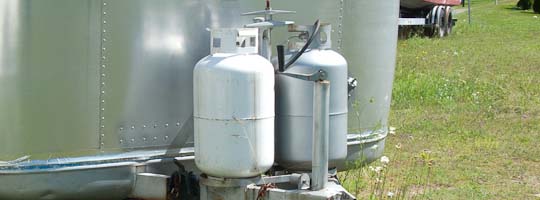Propane Cylinders and Tanks

Never overfill a propane cylinder or tank
The vapor space in the propane cylinder also provides room for the liquid propane to expand if the cylinder is exposed to warmer temperatures.
Never allow your propane cylinder or tank to be filled above the maximum safe level as indicated by a OPD, a scale or the fixed liquid level gauge. Do not use the visible gauge for filling.
If a cylinder is overfilled beyond 80 percent capacity there won't be enough vapor space to accommodate the expanding liquid if the cylinder is exposed to warmer temperatures. The pressure relief valve may open, discharging propane to relieve the pressure. Liquid propane could enter the piping system, resulting in higher than normal pressures to the appliances. If the cylinder becomes liquid full and the pressure relief valve fails to open, the container could rupture, resulting in serious injury or property damage.
DOT and ASME containers are different
Propane tanks for permanent installation are built to ASME Boiler and Pressure Vessel Code and their capacity is expressed in U. S. Gallons.
Propane cylinders for transportable use are built to DOT Hazardous Materials Regulations and their capacity is expressed in pounds of water.
All propane cylinders are not alike
CAUTION: USE PROPANE CYLINDERS AND TANKS IN PROPER POSITION
There are two basic types of portable propane cylinders – the vertical (upright) standard cylinder and the horizontal cylinder that comes with a special mounting bracket and which can be installed either vertically or horizontally. Both cylinders are manufactured in accordance with U.S. Department of Transportation (DOT) specifications.
When you purchase a new cylinder, be sure it fits the bracket you have. And if you use a cylinder exchange service, be sure the cylinder you receive is the same type as you turned in. Vertical cylinders are NOT designed for service while lying on their sides.
Propane appliances for cooking, heating, lighting, water heating and refrigeration are designed to operate on gas vapor only. Therefore cylinders and tanks designed for vapor service must be transported, installed and used in the proper position. Do not transport, install or use a vertical cylinder in a horizontal or upside down position. Proper care must be taken to position a horizontal container in the correct position for vapor withdrawal. Liquid propane could enter the system designed for vapor only, possibly creating a hazardous condition.
Cylinder requalification
Federal DOT (Department of Transportation) regulations require periodic inspections and re-qualifications of cylinders. DO NOT USE damaged or rusted containers.
Filling a DOT propane gas cylinder that has not been properly inspected and qualified violates federal law.
Securing propane tanks and cylinders
Propane gas containers and regulators must be installed and properly secured in or on your vehicle so as to minimize damage in the event of a collision or accident.
On travel trailers and tent trailers propane cylinders are usually mounted on the A frame as close to the front of the trailer body as possible.
On motor homes, vans, fifth wheel trailers or slide-in chassis-mounted units propane cylinders or tanks are usually mounted in a recessed compartment accessible only from and ventilated to the outdoors and gas tight to the interior of the vehicle. Pressure relief valves must be pointed away from the vehicle or toward the container compartment opening.
Because propane vapors are heavier than air, the compartments for all propane containers aboard your vehicle must be ventilated, both at the top and bottom, and completely sealed from the interior of your vehicle.
Propane gas cylinders should not be mounted on the roof or front of a vehicle.
NOTE: If your vehicle is involved in a collision or other accident, shut the gas supply off at the container and have the system checked by a qualified propane service person.
Propane cylinder maintenance
Propane is normally non-corrosive - you need not worry about the inside of your container. However, the outside should be kept free from rust by a periodic coat of paint in a light reflective color. It is very important to inspect and maintain the bottom and footring on the container. Aluminum cylinders do not require painting.
Transporting and storing propane cylinders
Always use a POL plug installed on a POL valve or a dust cap on an ACME/Type 1 valve when transporting or storing disconnected containers (full or empty). This will keep gas from escaping and prevent foreign material from entering the cylinder should the valve be opened accidentally.
Propane gas cylinders must be transported so the relief valve communicates with the vapor space at all times. For that reason, you should never transport a cylinder lying on its side unless it's a cylinder designed for horizontal use. Transport the container in the proper position in which it is used, with the valves closed and POL Plugs inserted for POL Valves, or Dust Caps for Acme Valves. Secure the tank against falling or rolling.
Never put full or empty cylinders in the passenger space or living area of your camper, RV or other vehicle.
Never store a cylinder inside a building, including a garage. Spare cylinders, for instance, should be stored outdoors and up off the ground on a non-combustible base.
Any cylinder that is damaged, shows signs of corrosion, has been exposed to fire, or appears to be leaking gas should be removed from service immediately. Store defective cylinders in a safe, outdoor location. Then as soon as possible, have them repaired or disposed of by a qualified service technician.
Do not attempt to repair any containers, container valves, regulator or appliances by yourself. Use only trained, certified service personnel to perform repairs.
Tags: Propane